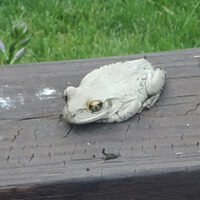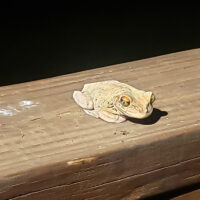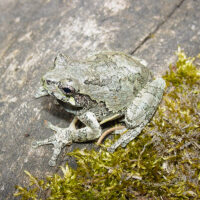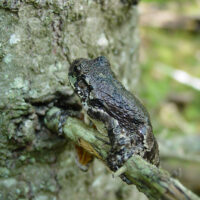 Purdue University - Extension - Forestry and Natural Resources
Purdue University - Extension - Forestry and Natural Resources
Got Nature? Blog
Documenting an occurrence of a new wildlife species for a region is usually good news. Unfortunately, with the number of non-native species that seemingly pop up, this is not always the case. Extension Specialists across the U.S. often receive inquiries about identifying pictures of wildlife. We were recently contacted by an individual to identify the “white frog” pictured below. It was clearly not a native species from Indiana but rather a Cuban treefrog.
The Cuban treefrog (Osteopilus septentrionalis) is native to Cuba, the Cayman Islands and the Bahamas. These treefrogs were accidentally brought to Florida in the 1920s, probably as hitchhikers in cargo containers on ships. Cuban treefrogs are considered invasive in Florida (and elsewhere outside their native range) because they are likely to harm our native ecosystems and cause a lot of problems for humans. They are voracious predators and have likely caused declines of native treefrogs in many suburban areas of peninsular Florida. They get into people’s homes and sometimes end up in toilets. And they are even known to invade electrical equipment and have caused power outages in Florida.
Cuban treefrogs are much larger than Indiana’s native treefrogs with adults typically reaching lengths of 2 to 3 inches and large females may grow to about 5 inches. Body color is highly variable, ranging from whitish to gray, green, or brown, and may be marked with irregular, dark stripes or blotches that fade when the frog changes color. Their skin is warty (some warts quite prominent) and have large “bug eyes.”. The armpits and groin may be washed with yellow.
Native gray treefrogs, which occur throughout Indiana, look a lot like Cuban treefrogs. However, gray treefrogs have granular skin and normally do not have individual warts that stand out from the rest of the bumpy skin on their back. Gray treefrogs also have a light-colored blotch directly below each eye.
How did the Cuban treefrog get to Indiana? That remains unclear, and this a very rare event for the Hoosier State. We only know of two other times Cuban treefrogs have shown up here. Both were discovered in ornamental plants shipped to Indiana from Florida. Cuban treefrogs spread by hitchhiking on ornamental plants, motorized vehicles, boats, etc. and it is also possible that this frog was someone’s pet that was either intentionally or accidently released. Cuban treefrogs are adapted to warm environments and it gets too cold in Indiana for this invasive frog to live here.
What can you do to help?
It is import to document the locations of Cuban treefrogs outside of Florida in the US and Canada. If you see a Cuban treefrog, or suspect you have seen one, outside of peninsular Florida please email Dr. Steve A. Johnson at tadpole@ufl.edu. Include your name, date you saw the frog, where you saw it (state, county, city, street address), and also attach a digital image so Dr. Johnson can positively identify the frog. It is also important to report Cuban treefrog sightings at EDDMapS, the online mapping system for invasive species in the US. Visit https://www.eddmaps.org/ and click the “Report Sightings” tab. Thank you for being a community scientist!
Cuban Treefrog Pictures (Non-native species)
Gray Treefrog Pictures (native species)
Resources
The Cuban Treefrog (Osteopilus septentrionalis), University of Florida- Institute of Food and Ag Sciences (IFAS) Extension
Invasive Cuban Treefrogs, Department of Wildlife Ecology & Conversation, University of Florida
Sounds of Frogs and Toads of Indiana, Purdue Extension – Forestry and Natural Resources
Ask An Expert: Anurans (Frogs and Toads), Got Nature? Blog, Purdue Extension – Forestry and Natural Resources
Frogs and Toads of Indiana, The Education Store, Purdue Extension resource center
A Moment in the Wild, Playlist, Purdue Extension – Forestry and Natural Resources
Forestry Management for Reptiles and Amphibians: A Technical Guide for the Midwest, The Education Store
Appreciating Reptiles and Amphibians in Nature, The Education Store
Nature of Teaching website and YouTube Playlist, Purdue Extension
Steve Johnson, Associate Professor
Dept. of Wildlife Ecology & Conservation, University of Florida
Brian MacGowan, Extension Wildlife Specialist
Department of Forestry and Natural Resources, Purdue University

Recent Posts
- Farmers Helping Hellbenders RCPP Program Accepting Applications
Posted: May 1, 2024 in Aquaculture/Fish, Forestry, How To, Wildlife, Woodlands - Extension Specialist Brian MacGowan Receives Hoosier Wildlife Award
Posted: in Forestry, Wildlife - MyDNR – First positive case of chronic wasting disease in Indiana
Posted: April 29, 2024 in Alert, Disease, How To, Safety, Wildlife - Publication – Introduction to White-tailed Deer Impacts on Indiana Woodlands
Posted: April 28, 2024 in Forestry, Land Use, Plants, Publication, Wildlife, Woodlands - Publication – Understanding White-tailed Deer and Their Impact on Indiana Woodlands
Posted: in Forestry, Land Use, Plants, Publication, Wildlife, Woodlands - Publication – Monitoring White-tailed Deer and Their Impact on Indiana Woodlands
Posted: in Forestry, Land Use, Plants, Publication, Wildlife, Woodlands - Publication – Managing White-tailed Deer Impacts on Indiana Woodlands
Posted: in Forestry, Land Use, Plants, Publication, Wildlife, Woodlands - Report Spotted Lanternfly – Purdue Landscape Report
Posted: April 10, 2024 in Alert, Forestry, Invasive Insects, Plants, Wildlife, Woodlands - Declining Pines of the White Variety – Purdue Landscape Report
Posted: in Alert, Disease, Forestry, Plants, Wildlife, Woodlands - Are you seeing nests of our state endangered swan? – Wild Bulletin
Posted: April 9, 2024 in Alert, Forestry, How To, Wildlife
Archives
Categories
- Alert
- Aquaculture/Fish
- Aquatic/Aquaculture Resources
- Ask the Expert
- Christmas Trees
- Community Development
- Disease
- Drought
- Forestry
- Forests and Street Trees
- Gardening
- Got Nature for Kids
- Great Lakes
- How To
- Invasive Animal Species
- Invasive Insects
- Invasive Plant Species
- Land Use
- Natural Resource Planning
- Nature of Teaching
- Plants
- Podcasts
- Ponds
- Publication
- Safety
- Timber Marketing
- Uncategorized
- Urban Forestry
- Webinar
- Wildlife
- Wood Products/Manufacturing
- Woodland Management Moment
- Woodlands



